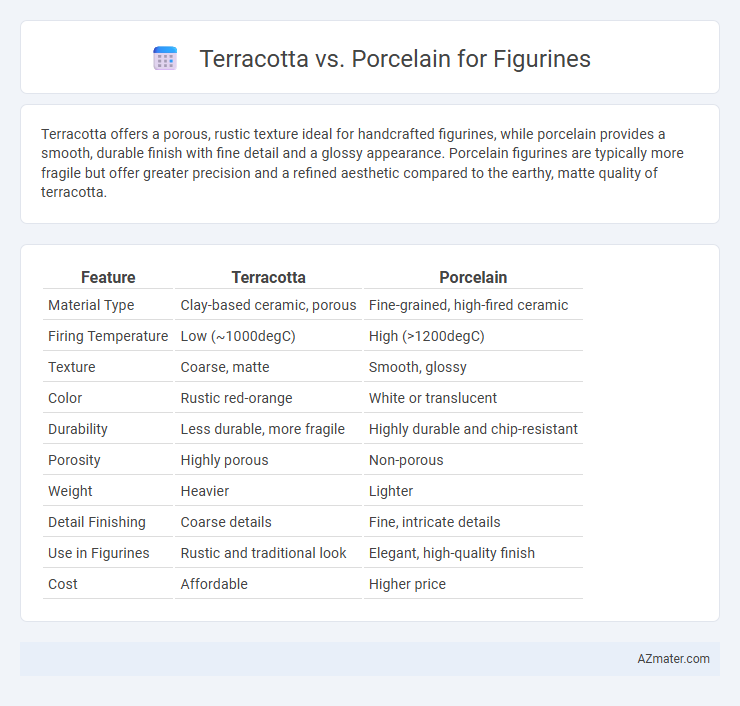Terracotta offers a porous, rustic texture ideal for handcrafted figurines, while porcelain provides a smooth, durable finish with fine detail and a glossy appearance. Porcelain figurines are typically more fragile but offer greater precision and a refined aesthetic compared to the earthy, matte quality of terracotta.
Table of Comparison
| Feature | Terracotta | Porcelain |
|---|---|---|
| Material Type | Clay-based ceramic, porous | Fine-grained, high-fired ceramic |
| Firing Temperature | Low (~1000degC) | High (>1200degC) |
| Texture | Coarse, matte | Smooth, glossy |
| Color | Rustic red-orange | White or translucent |
| Durability | Less durable, more fragile | Highly durable and chip-resistant |
| Porosity | Highly porous | Non-porous |
| Weight | Heavier | Lighter |
| Detail Finishing | Coarse details | Fine, intricate details |
| Use in Figurines | Rustic and traditional look | Elegant, high-quality finish |
| Cost | Affordable | Higher price |
Introduction to Terracotta and Porcelain Figurines
Terracotta figurines are crafted from natural clay and fired at lower temperatures, producing a porous, earthy texture that is ideal for traditional and rustic designs. Porcelain figurines, made from a refined kaolin clay and fired at much higher temperatures, offer a smooth, durable, and translucent finish prized for intricate details and fine artistry. Both materials have unique characteristics influencing their aesthetic appeal, durability, and suitability for different styles of collectible figurines.
Material Composition and Properties
Terracotta figurines are made from natural clay baked at lower temperatures, resulting in a porous, slightly rough texture that absorbs moisture, making them more fragile and less durable. Porcelain is composed of refined kaolin clay and fired at very high temperatures, creating a dense, non-porous, and smooth surface with superior strength and resistance to chipping. The intrinsic material composition of terracotta offers an earthy, matte finish, whereas porcelain provides a glossy, fine detail ideal for intricate figurine artistry.
Historical Background and Origins
Terracotta figurines trace their origins to ancient civilizations such as Mesopotamia and the Indus Valley, where they were crafted from porous clay and fired at lower temperatures, making them accessible and versatile for artistic expression. Porcelain figurines emerged later during the Tang Dynasty in China, known for their high-temperature firing that produces a dense, white, and translucent material prized for delicate and detailed craftsmanship. The distinct historical development of terracotta and porcelain reflects their cultural significance and technological advancements in ceramic art.
Production Techniques Compared
Terracotta figurines are crafted using natural clay, shaped by hand or wheel, and then air-dried before firing at lower temperatures, resulting in a porous and earthy texture. Porcelain figurines involve refined kaolin clay, molded with precision and fired at extremely high temperatures, which creates a dense, smooth, and translucent finish. The production techniques for terracotta emphasize rustic charm and artisanal individuality, while porcelain demands precise temperature control and sophisticated glazing for a refined, durable product.
Durability and Longevity
Terracotta figurines, made from porous clay, are more prone to chipping and weathering over time compared to porcelain, which is fired at higher temperatures to achieve a dense, non-porous surface. Porcelain's vitrified structure ensures superior resistance to cracks, stains, and environmental factors, enhancing durability and longevity. Collectors often prefer porcelain for long-lasting figurines due to its resilience and ability to maintain fine details without deterioration.
Aesthetic Appeal and Surface Finish
Terracotta figurines offer a warm, earthy aesthetic with a matte, porous surface that highlights natural textures and color variations, enhancing rustic charm. Porcelain figurines provide a smooth, glossy finish with fine detailing and a refined, elegant look due to their dense, non-porous composition. The choice between terracotta and porcelain depends on the desired artistic style and the importance of surface sheen in the figurine's presentation.
Cost and Affordability
Terracotta figurines typically cost less due to lower material and firing expenses, making them a more budget-friendly option for collectors. Porcelain figurines, crafted from refined clay and fired at higher temperatures, generally carry a higher price point reflecting their durability and intricate detail. Choosing between terracotta and porcelain depends on affordability preferences and desired longevity for the figurine.
Suitability for Detailing and Intricate Designs
Terracotta offers excellent suitability for figurines requiring fine detailing due to its softer, more malleable clay, which allows artists to easily carve and shape intricate designs before firing. Porcelain, though harder and more delicate after firing, provides a smooth, refined surface that highlights subtle details and intricate craftsmanship with a translucent finish. The choice between terracotta and porcelain depends on whether the priority is ease of sculpting detailed features or achieving a polished, delicate final appearance.
Maintenance and Care Tips
Terracotta figurines require careful sealing and regular dusting to prevent moisture absorption and surface degradation, while porcelain figurines benefit from a smooth, non-porous surface that resists stains and is easier to clean with a soft cloth and mild detergent. Terracotta's porous nature makes it more susceptible to chipping and cracking, necessitating gentle handling and occasional resealing with a protective coating. Porcelain, known for its durability and glossy finish, demands less frequent maintenance but should be kept away from sharp impacts and extreme temperature changes to preserve its pristine appearance.
Choosing the Right Material for Your Figurine
Terracotta figurines offer a rustic, earthy aesthetic with excellent breathability and affordability, making them ideal for handcrafted or vintage-style pieces. Porcelain figurines provide a smooth, durable, and highly detailed finish that enhances fine detailing and longevity, often favored for delicate and collectible art pieces. Choosing the right material depends on the desired texture, durability, and level of detail, with terracotta suited for warmth and tradition, while porcelain excels in refinement and precision.

Infographic: Terracotta vs Porcelain for Figurine
 azmater.com
azmater.com